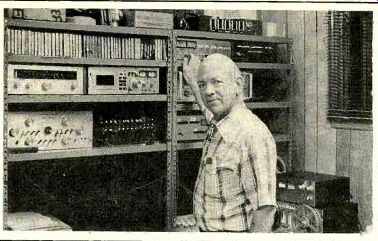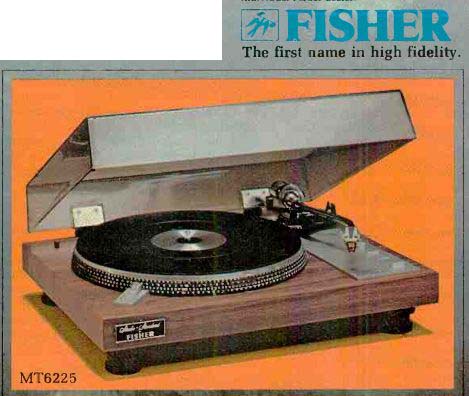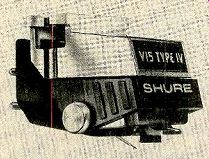
By
Julian D. Hirsch
The Testing of Turntables
ALTHOUGH turntables are sometimes sold as separate components, they can not be used or tested except in combination with an arm and a cartridge. It is not possible to evaluate any of these components without the other two, and often it is impossible to completely separate the contributions of each to a given measured result.

Last month I discussed this problem as it applies to the testing of tone arms. The same considerations apply to turntable testing. In fact, the two are tested simultaneously, the only difference being that some of the tests and specific test records are peculiar to one or the other component. The basic turntable performance measurements include speed ac curacy, speed constancy (including drift, wow, and flutter), freedom from mechanical vibration (rumble), isolation from structure- or air-conducted vibration, and, in the case of a turntable with automatic or other special features, an assessment of how effectively they function.
If, as is the usual case, no cartridge is supplied with the turntable or specified for use with it, we generally install a suitable cartridge that happens to be on hand for testing.
(If none is available, the Shure M95ED serves as our all-purpose standby cartridge.) After the cartridge has been installed and the necessary adjustments made for arm geometry and tracking and antiskating force, the record player is placed on a heavy, rigid, and accurately horizontal surface, one that is as isolated as possible from external shock and vibration. The cartridge output is amplified to the required levels for measurement by means of the amplifier function of our Ballantine Model 310 a.c. voltmeter.

For speed checks, the output of the meter amplifier goes to a Heath IB-101 frequency counter. While playing the standard-level 1,000-Hz band of a CBS STR 100 record, we measure the frequency on the counter. If the turntable has a stroboscope and a speed adjustment, this is set accurately to 33 1/2 rpm. At this time the counter should read exactly 1,000 Hz. If it does not, the stroboscope marks may be in error or the light flashing at the wrong frequency (these are very remote possibilities, but we have encountered both of them in the past). If the speed is not adjustable, the counter reading gives us an accurate measurement of the true turntable speed. If vernier speed adjustments are provided, they are moved to their limits and the counter reading is noted at each of the turntable's rated operating speeds. From this it is easy to compute the speed accuracy and the vernier con trol range. We also change the a.c. line volt age, usually between the limits of 95 and 135 volts, and observe any changes in the frequency of the "playback signal"--which is, of course, the platter speed.
With the speed set at 33 1/2 rpm, the output of the meter amplifier is connected to the in put of a flutter meter. Until recently we used a meter based on the old IRE standard of 1954, which was essentially an unweighted average measurement. We have now replaced it with a Meguro MK-667C flutter meter which has all the currently used measurement weighting curves and meter characteristics. These include the JIS, NAB, CCIR, and DIN standards (the last is similar to the current ANSI/ IEC/IEEE standard). The DIN and CCIR systems use a peak measurement in which the flutter is expressed as "±x per cent"; they differ only in the measurement frequency (the DIN uses 3,150 Hz and the CCIR uses 3,000 Hz). The NAB and JIS systems use similar weighting curves. Both operate at 3,000 Hz, but the NAB is an "average-reading" measurement and the JIS is a heavily damped rims measurement. In the future we can expect to encounter better correlation between our flutter measurements and those specified by turn table (and tape-recorder) manufacturers, if for no other reason than that we will be measuring with the same yardstick.
The flutter meter has an output at which the demodulated flutter waveform-the actual flutter frequencies and amplitudes--is avail able for external analysis. We connect this to our Hewlett-Packard 3580A spectrum analyzer and make a frequency analysis of the flutter spectrum from 0 to 200 Hz. This can give us clues to the origin of the flutter by showing whether it consists largely of discrete frequency components or is randomly distributed (which is usually the more audible).
To measure flutter, we must play a record that has the required frequency of 3,000 or 3,150 Hz recorded with a very low intrinsic flutter (ideally much less than the flutter in the component being tested). Some CBS test records, such as the BTR150, have 3,000-Hz flutter bands, but we usually use the DIN 45545 record, which is recorded at 3,150 Hz. The meter can function properly with this frequency even when it is set for JIS or NAB measurements.
It probably comes as a shock to anyone making a flutter measurement for the first time to see how much the meter reading varies. There is as much art as there is science in making a flutter measurement, since one must "eyeball" the meter and estimate its most probable reading. Occasional swings to a much higher reading can usually be ignored, but some sort of mental averaging is required to interpret the wildly swinging meter pointer.
Although the various weighting systems employed in the Meguro instrument tend to lump flutter and wow together in a combined measurement, internal filters can be switched in for a wow-only measurement. These limit wow measurement to the band from either 0.2 or 0.5 Hz up to 6 Hz, and flutter consists of the components from 6 to 200 Hz. Everything below 0.2 Hz down to zero frequency is classified as drift, for which the Meguro de vice has a second meter. However, if a turntable has appreciable low-frequency wow, or if the record is slightly eccentric, there will be a deflection of the drift meter accompanying the reading of the flutter meter.
To measure rumble, the cartridge plays a special unmodulated ("silent-groove") record. The cartridge output is passed though an accurate RIAA-equalized preamplifier and then to the Ballantine meter on which the readings are made. For an unweighted measurement, we first establish a reference level on the meter by playing a recorded signal of 100 Hz at a 1.4-centimeter-per-second (cm/ sec) velocity (equivalent to 1,000 Hz at 5 cm/ sec). Then the silent-groove record is played, and the meter reading is observed. The difference between the reference level and the si lent-groove level is expressed as a rumble level of "-x dB." Care is needed to avoid hum pickup that can place an artificial "floor" un der the readings, exaggerating the actual rumble level.
The output of the preamplifier also goes to the spectrum analyzer, so that we can deter mine the frequency distribution of the rumble waveform. Sometimes discrete rumble frequencies are found-at frequencies between 10 and 120 hz-that are associated with the pole structure of a direct-drive motor, or the rotation rate of a conventional synchronous or induction motor. We also often find a peak in the rumble spectrum at the frequency of the low-frequency arm/cartridge resonance (typically 7 to 10 Hz).
This unweighted rumble measurement is in formative because it indicates how much infrasonic energy will reach the amplifier and speakers (unless the energy is filtered out by the amplifier). This can cause amplifier over load, speaker distortion, or even speaker damage in extreme cases. However, almost all manufacturers' turntable specifications state a weighted rumble figure, which generally correlates better with the audibility of the rumble. Each measurement system (JIS, NAB, ARLL) attenuates the low rumble frequencies by a different amount, making comparisons between them impossible.
We use the ARLL weighting curve originated by the CBS Technology Center. It is convenient and, so far as we can tell, as valid as any of the others, although the numerical results of the measurement may not be as impressive as a JIS or DIN-B measurement.
Essentially, it rolls off the low frequencies be low 500 Hz at a 6-dB-per-octave rate. Since the ARLL network is driven from the output of an RIAA-equalized preamplifier, with its 6-
dB-per-octave boost below 500 Hz, the net effect is nearly that of an unequalized cartridge output measurement.
As with flutter measurements, the meter readings in rumble measurements are highly variable. Often the rumble-frequency components will be close to the frequency of the a.c.
power line or one of its harmonics, and the resulting "beats" will cause the meter pointer to swing over a very wide range so that visual averaging is again needed. Even more than in a flutter measurement, the test record chosen is highly significant. Every such record has some rumble built in; there is no such thing as an absolutely "silent groove," any more than there is a "distortionless amplifier." Most of our initial rumble measurements are made with an AR test record that also has the 100-Hz reference-level band. Its rumble is low enough for many turntables, but if we suspect that we may be measuring the record rather than the turntable, we play a DIN 45544 rumble test record, and if the turntable is one of the better models, we resort to a lacquer disc that was cut specially for us, one with an intrinsic rumble lower than-70 dB.
Yet, no matter how good the record may be, there are other factors to consider. For example, the lacquer disc has two silent-groove bands cut at different radii. Usually the measured rumble will be higher on one band than on the other; we use the best figure we can measure (this is not a property of the record, but varies according to the turntable).
It should be apparent that many aspects of turntable measurement are, to say the least, arcane. It is not the sort of thing one can do in a "cookbook" fashion, or by following writ ten instructions, and expect to get meaningful results. This should point up the futility of worrying about minor differences between the rumble or flutter ratings of different turntables and using them as a basis for selection. Aside from possible differences in instrumentation, a variation of several decibels can result from different visual interpretations of the same meter readings.
It is now recognized that one of the most important properties of a record player is how it responds to vibrations reaching it through the air or conducted through its mounting feet. Ideally, there should be no response to such vibrations. Practically speaking, of course, one cannot completely isolate the physical record player from the surface on which it rests or from the surrounding air that carries sounds from the speakers and other sources.
A full evaluation of the effectiveness of the turntable suspension would be very costly and difficult to perform. Furthermore, no matter how thoroughly it was done, one could never be certain that the test was complete.
For example, a given record player will respond very differently to stimuli acting on it from different directions--not just from side front to back, but along any line in a sphere surrounding the entire record player.
While I recognize the impossibility of doing a truly rigorous test of turntable isolation, I would still prefer to do a partial job than to ignore the matter entirely. I do this with the aid of a "poor man's shake table" whose design was proposed by Technical Director Larry Klein. It has given us excellent service over the past several years. It consists of four small loudspeaker drivers that were originally meant to be fastened to wall studs to convert one's wallboard into an acoustic radiating surface (!). Four of these drivers hold up the corners of a piece of 1/4-inch-thick plexiglass large enough to support any turntable likely to be tested. They are driven in phase from a power amplifier whose input signal is derived from the sweeping signal generator of our General Radio frequency-response plotter.
The record player is set up in a normal playing position on top of the plastic. The cartridge is placed on a record (with the turntable stationary). The output of one channel, amplified by an RIAA-equalized preamplifier, goes to the input of the chart recorder, which is synchronized with the frequency sweep of the generator. With a standard drive level applied to the "speakers," the frequency is slowly swept from 20 to 1,000 Hz. The cartridge output, the result of the transmitted vibration's moving the stylus relative to the turntable (or vice versa), is plotted on the chart as a function of frequency. The vertical (amplitude) scale is corrected by a factor de rived from the setting of the chart recorder's input attenuator and the output of the cartridge when it is playing a standard 1,000-Hz, 3.54-cm/sec test tone from a CBS STR 100 test record.
THESE plots, in themselves, tell us little more than the frequencies at which the record player is most susceptible to base-conducted vibration. There are no absolute quantitative data in the curves, and there are inevitable un certainties due to the unknown loading effects of different turntable weights on the vibrators themselves. The real value of this measurement is that it permits us to make comparisons, crude though they may be, between different record players. By overlapping their charts, altering their positions to allow for the corrective scale factors mentioned earlier, and holding the charts up to the light, it is easy to see which player responds most strongly to the vibration, and at what frequencies. From this comparison, we can judge with fair ac curacy whether a turntable is better or worse than the average of its competitors in this very important respect.
Burwen THE 7000 Noise Eliminator Shure V15 Type IV Cartridge Dynaco Stereo 416 Power Amp Wharfedale E-70 Speaker System Teac A-103 Stereo Cassette Deck
Also see:
Source: Stereo Review (USA magazine)